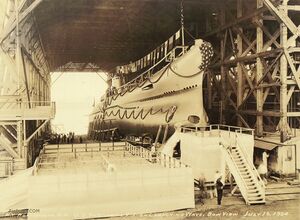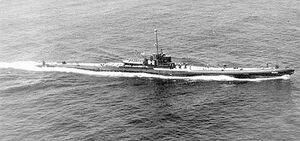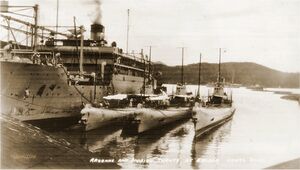V-1 Class: Difference between revisions
Pbcjohnston (talk | contribs) Added photos |
Pbcjohnston (talk | contribs) Added notes section |
||
| Line 1: | Line 1: | ||
[[File:Header 3 New.jpg]] | [[File:Header 3 New.jpg]] | ||
===<big>Design, Construction, and Naming Notes</big> === | ===<big>Design, Construction, and Naming Notes</big> === | ||
<div style="text-align: justify;"><span style="color:#00008B"> | <div style="text-align: justify;"><span style="color:#00008B">The V-class fleet submarines had originally been authorized in 1916, as a follow-on to the T-class. The need to get the wartime building programs, i.e. the O, R, S, and T-classes completed and the limited shipyard space when the other shipbuilding programs were taken into account, served to delay the V-class construction. This was somewhat fortuitous, as the USN was rapidly gaining wartime operating experience, and intelligence reports of how allied and enemy submarines were being operated in the eastern Atlantic were being collected and analyzed. Fleet surface actions such as Jutland were also influencing submarine design. The desire for a submarine to be capable of operating as a battle line adjunct was reinforced. The near total failure of the preceding T-class did not diminish the perceived need for a fleet submarine, and the Navy plunged ahead with the design of the new V-class with gusto. | ||
With only the obsolete design of the T-class as a guide, the Navy"s General Board incorporated a rash of new ideas into the design; the highly ambitious technical nature of a submarine operating with the fleet compelling them to push the boundaries. The hull design for V-1 to V-3 was loosely based on the Italian Laurenti design, with non-circular cross sections that provided more useable internal space, but ultimately reduced hull strength. They had two direct drive Busch-Sulzer diesels, and two additional generator diesels in a second engine room situated ''forward'' of the control room, with crew's quarters in a mezzanine deck inside the forward engine room. When viewed bow on in drydock, the hull form took on an almost a figure-eight look, with a bulbous, porpoise-like upper portion, a very narrow, almost knife-like section below that, and finally with the hull flaring back out at the bottom to accommodate the four torpedo tubes. The main deck topside had a pronounced upward sheer as it moved towards the flared bow, and a downward sheer as it moved aft towards the tip of the stern. Internal aft torpedo tubes were incorporated for the first time since the [[G-4|'''G-4 (SS-26)''']]. However, the tubes were in their own watertight compartment separate from the torpedo stowage, necessitating the movement of the reload weapons through a watertight door, a very awkward arrangement. The engines were underpowered and very unreliable. | |||
All three boats were built by the Portsmouth Navy Yard in Kittery, ME. When commissioned they were named V-1 (SF-4), V-2 (SF-5), and V-3 (SF-6). On February 19, 1931, they were renamed Barracuda, Bass, and Bonita, and were redesignated into the general SS series. | |||
These boats were ultimately not successful, despite wide ranging service to the fleet. They technology existing at the time could not support the fleet submarine concept. These boats had poor sea-keeping characteristics, unreliable and underpowered engines, awkward handling, and weak hulls. They were decommissioned in 1937 and laid up in reserve in Philadelphia. | |||
The pressures of WWII forced the Navy to press them back into service, and they lived up to their poor reputation. At the behest of President Roosevelt himself, they were converted to cargo carriers with the idea that they could resupply isolated island garrisons. In this role their torpedo tubes and main propulsion diesels were removed to make cargo space. The boats were propelled by their generator diesels only. Their crews viewed this mission as a near suicide assignment, and the boats never made an operational cargo run. They were finally decommissioned in March 1945, un-mourned by the Navy. Barracuda and Bass were promptly scrapped, and Bass (having previously suffered a disastrous battery fire) was sunk as a target in the Atlantic off Block Island.</span><div> | |||
[[File:Red bar sub new.jpg]] | [[File:Red bar sub new.jpg]] | ||
Revision as of 11:49, 2 July 2023
Design, Construction, and Naming Notes
With only the obsolete design of the T-class as a guide, the Navy"s General Board incorporated a rash of new ideas into the design; the highly ambitious technical nature of a submarine operating with the fleet compelling them to push the boundaries. The hull design for V-1 to V-3 was loosely based on the Italian Laurenti design, with non-circular cross sections that provided more useable internal space, but ultimately reduced hull strength. They had two direct drive Busch-Sulzer diesels, and two additional generator diesels in a second engine room situated forward of the control room, with crew's quarters in a mezzanine deck inside the forward engine room. When viewed bow on in drydock, the hull form took on an almost a figure-eight look, with a bulbous, porpoise-like upper portion, a very narrow, almost knife-like section below that, and finally with the hull flaring back out at the bottom to accommodate the four torpedo tubes. The main deck topside had a pronounced upward sheer as it moved towards the flared bow, and a downward sheer as it moved aft towards the tip of the stern. Internal aft torpedo tubes were incorporated for the first time since the G-4 (SS-26). However, the tubes were in their own watertight compartment separate from the torpedo stowage, necessitating the movement of the reload weapons through a watertight door, a very awkward arrangement. The engines were underpowered and very unreliable.
All three boats were built by the Portsmouth Navy Yard in Kittery, ME. When commissioned they were named V-1 (SF-4), V-2 (SF-5), and V-3 (SF-6). On February 19, 1931, they were renamed Barracuda, Bass, and Bonita, and were redesignated into the general SS series.
These boats were ultimately not successful, despite wide ranging service to the fleet. They technology existing at the time could not support the fleet submarine concept. These boats had poor sea-keeping characteristics, unreliable and underpowered engines, awkward handling, and weak hulls. They were decommissioned in 1937 and laid up in reserve in Philadelphia.
The pressures of WWII forced the Navy to press them back into service, and they lived up to their poor reputation. At the behest of President Roosevelt himself, they were converted to cargo carriers with the idea that they could resupply isolated island garrisons. In this role their torpedo tubes and main propulsion diesels were removed to make cargo space. The boats were propelled by their generator diesels only. Their crews viewed this mission as a near suicide assignment, and the boats never made an operational cargo run. They were finally decommissioned in March 1945, un-mourned by the Navy. Barracuda and Bass were promptly scrapped, and Bass (having previously suffered a disastrous battery fire) was sunk as a target in the Atlantic off Block Island.V-1/Barracuda (SF-4, later SS-163)

V-2/Bass (SF-5, later SS-164)

V-3/Bonita (SF-6, later SS-165)

General group photos

Page created by:
Ric Hedman & David Johnston
1999 - 2023 - PigBoats.COM©
Mountlake Terrace, WA, Norfolk, VA
webmaster at pigboats dot com
